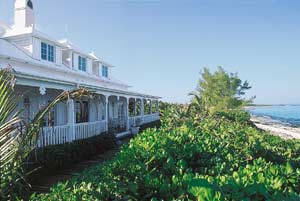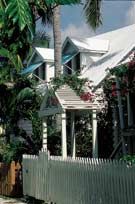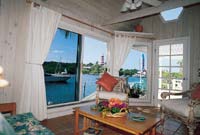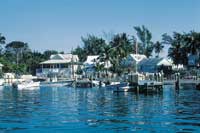| You are here: Home > Abaco Life > This Month's Features |
![]()
|
NO LONGER HUMBLE, ABACO HOMES STILL REFLECT LOYALIST
HISTORY Abaco's early settlers lacked interest in appearances. A house was a place where you survived the wind and the rain and the summer heat. You stored water beneath it and salt in boxes, and the kitchen was a separate building outside so the house wouldn't burn down in case of fire. The house was usually turned away from the sea, its back to the sound of surf and blowing sand. And when you built your "home, sweet home," you had to take into account materials and skills at hand.
Once the fundamentals of survival were mastered in Abaco living, loyalist descendants began to adapt some of the old styles and designs they had brought to this unique island environment, using shipbuilding skills and techniques they had developed in this world of the sea. Steep staircases, built like those on a wrecking schooner, led upstairs to attic-like spaces used for additional sleeping quarters. The steeply peaked roof funneled precious rainwater to underground cisterns, but the space under the roof was cramped and hot, so dormers and gable windows were cut for light and ventilation. Outside, white picket fences began to sprout in the yard; then porches with draping gingerbread were added. Today in Abaco there are many modern designs, but generally the loyalist look has survived and been preserved in communities such as Hope Town on Elbow Cay, Guana Harbour on Great Guana Cay, New Plymouth on Green Turtle Cay and Cherokee Sound in South Abaco. Many of the houses dating back 100 years or more have been restored or renovated. And newly built houses, while reflecting a wide range of architectural ideas, have a distinct island flair. "The pitch of the roof is the most important feature," says
Michael Myers, a landscape architect who lives in Hope Town. "It sets
the mood. You can get away with a lot of other things, but the angle of
the roof sets the loyalist ambiance. It's like a woman's hat. It draws
your attention." His own house features a widow's walk, a little porch atop the house that commands a panoramic view of the harbour and sea beyond. He and his wife, Patte, restored the hilltop home at the harbour's entrance several years ago, opening up the house's small, interior rooms into a great room with a kitchen and dining area that looks out onto a lush, tropical garden. The house is refered to as "The Wedding Cake House" because of its gingerbread trim, pure white colour and unusual, rounded shape. Bougainvillea, banana plants, hibiscus and other flowering scrubs combine into a delighful and comforting scene just outside the door. Hope Town has become much more tropical in recent years as home owners plant a combination of Caribbean and Florida plants, all of which thrive on little rainfall. Evidence of this man-induced tropical abundance can be seen in landscaping all over Abaco, from beachfront and waterfront homes at Treasure Cay and Green Turtle Cay to the backyards of Marsh Harbour and Man-O-War Cay. Several nurseries on Abaco provide the plants, while amateur horticulturists and professional landscapers do the rest.
"Renovation is expensive," says Kevin Albury, a popular builder on Elbow Cay. "It's hard, dirty work, but it looks good when it's finished. Abaco pine used in the original construction is usually good for another 100 years, but exterior siding, shutters and all the interior usually has to be redone." Nails were unavailable in Abaco during early construction, so wooden pegs were used. Mortise and tenor were used for joints. Today, a new woodframe house built in the old style is likely to have a concrete foundation and standard asphalt shingles with cement-based siding that looks like wood. Many residents have also added artistic trimming and extensions to older houses. Woodcarver and sculptor Russ Ervin built a large front porch on his harbourfront home in Hope Town with pineapple pattern designs and gingerbread. The original design of the house, built here in the 1800s by loyalist descendants, was first introduced into Charleston by French immigrants. Early builders feared hurricanes would rip frills such as porches off the house and blow them away. Russ' house, like many others on the cays, was built with the front door along the side, another precaution against rising water. Few property owners today would forego a waterfront - and especially oceanfront - view because of the exposure. At "Villa Pasha" on Green Turtle Cay, owner Paul Thompson built his beachfront home with a series of French doors around the house to enhance the feeling of openness and the view. The design is based on a Caribbean style home built in Guadeloupe around 1874. Great Abaco Club in Marsh Harbour offers a wide variety of designs to new home builders in this gated, waterfront community, but all designs have an open, island style, and you can have any colour you want as long as it's pastel. Both the club's architectural committee and a town architectural committee have to approve the plan. Construction costs run from $100 to $170 a square foot, and every upgrade is available. from Bermuda roofs to Italian tiles. Unlike the bare-bones, utilitarian furniture used by early islanders, many of the new or restored homes in Abaco today are furnished in colonial antiques, wicker or rattan. Local craftsmen, like Bill Fuller on Elbow Cay, also make Caribbean and plantation-style furniture that adds to a relaxed, casual but upscale island look. Paintings, shell art, driftwood sculpture and other decorations adorn walls and shelves. Perhaps the most impressively decorated of all is the home of Abaco artist Alton Lowe on Green Turtle Cay where the walls are covered with his original oils, both inside the house and in the adjoining Lowe Gallery. Some of the outdoor scenery and salt air may remain essentially the same as it was in 1783, but life in Abaco has reached a level of comfort and aesthetics never envisioned by those early settlers. Hardwood floors and modern indoor kitchens prevail - not to mention tiled bathrooms and cozy bedrooms with a beach view. It doesn't get much better than this. |
© 2000 Abacoinfo.com All Rights Reserved.
Stories reproduced with express permission from Abaco Life.
Stories published from the Abaco
Life Magazine are © 2000 Abaco Life.
To obtain all the stories contained within this publication click
here to subscribe.

 But the
loyalist settlers who started arriving here in 1783 also came with ideas,
brought from New England and colonial cities in the U.S., such as
Charleston, South Carolina. Charleston itself had been heavily influenced
by the French, and by English islanders sailing up from the Caribbean.
But the
loyalist settlers who started arriving here in 1783 also came with ideas,
brought from New England and colonial cities in the U.S., such as
Charleston, South Carolina. Charleston itself had been heavily influenced
by the French, and by English islanders sailing up from the Caribbean.
 Abaco's
construction industry is also booming. Architects, designers and builders
are backed up with pending projects, many of them involving foreign owners
seeking both full and part-time residence. Renovation of older houses is
still popular, but with plenty of building materials now available from
local hardware stores and lumberyards, as well as efficient freight
operations from Florida and Marsh Harbour, many builders would rather
start from scratch.
Abaco's
construction industry is also booming. Architects, designers and builders
are backed up with pending projects, many of them involving foreign owners
seeking both full and part-time residence. Renovation of older houses is
still popular, but with plenty of building materials now available from
local hardware stores and lumberyards, as well as efficient freight
operations from Florida and Marsh Harbour, many builders would rather
start from scratch.